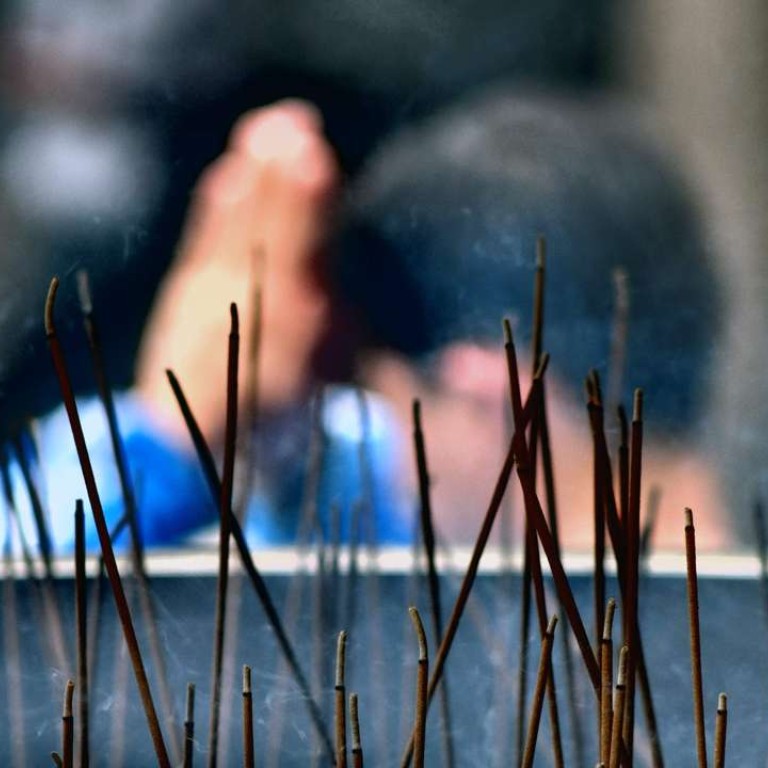
Taiwan temples go green in battle to reduce smog
Worshippers asked to embrace alternative practices that don’t pollute air
Smoke billows daily from temples across Taiwan as visitors burn incense and paper money to bring luck and prosperity – but that familiar fragrant haze could be a thing of the past as concerns grow over ritual pollutants.
The potential damage to the environment and to the health of devotees from staggering levels of dangerous particles in the air is leading some temples and festivals to seek alternative – if less spectacular – practices, despite resistance from worshippers.
Famous temples such as the Taoist Nan Yao in central Changhua city – one of the island’s largest and oldest temples – are playing firecracker CDs instead of launching the real thing, as well as encouraging followers to clap hands to create smoke-free noise.
Landmark study of elderly Hongkongers ties air pollution to multiple types of cancer
The Taoist Hsing Tian Kong temple in Taipei has banned worshippers from burning incense, requesting they simply bring their hands together to pray, instead of holding the burning sticks.
Other temples are sending paper offerings to be burned at state incinerators so the fumes can be treated.

And in New Taipei City, water lanterns that pollute the river have been replaced with a wall of lanterns outside a temple. While the new alternatives may not be quite as atmospheric, activists say it is time for change.
People come to temples to pray for good health, but the way they are worshipping is not healthy
“People come to temples to pray for good health, but the way they are worshipping is not healthy,” said Yeh Guang-perng, founder of the environmental group Air Clean for Taiwan. “They might not get sick right away, but long-term exposure would be harmful to their health.”
Taoism and Buddhism are the predominant faiths in Taiwan, each with millions of followers and with worship centring around temples and festival events.
During a nine-day pilgrimage last month in central Taiwan honouring the Taoist sea-goddess Mazu, government monitoring revealed levels of harmful microscopic PM2.5 particles reached more than 60 times the World Health Organisation’s recommended levels along the route after multiple firecrackers were set off.
A silver lining in the cloud over China’s environmental challenges
Environmental groups have also warned over hazardous chemicals, such as benzene and methylbenzene, released from burning incense and paper money.
But some devotees are reluctant to let go. “The traditional belief is that the more firecrackers and incense used, the sincerer the faithful will appear and the more good fortune will be bestowed on them,” said Chiu Jainn-fuh, director of Nan Yao Temple.

The temple for the first time cancelled a budget of NT$1 million (HK$240,000) for setting off firecrackers at a recent Mazu pilgrimage it hosted, but about half of its devotees refused to follow suit and set off their own, he said.
Dajia Jenn Lann Temple, in central Taichung city, also Taoist, is encouraging worshippers to dedicate fresh flowers and fruits to deities, and to donate the money they would spend on firecrackers to charity.
Again, the reaction has been mixed from worshippers. “Actually the smog coming from China is far more serious. Air pollution is not caused by religious activities alone,” read one message on the temple’s Facebook page.
Some followers are unhappy, especially elderly people who think they are being disrespectful
“Some followers are unhappy, especially elderly people who think they are being disrespectful and we can’t force them. It’s not easy to change and it takes time,” said Yen Chin-piao, president of the temple.
Authorities are banking on a scientific approach to persuade sceptical worshippers to go green.
The levels of PM2.5 registered at last month’s main Mazu festival pilgrimage were posted real-time online by Taiwan’s Environmental Protection Administration (EPA), which sent a dedicated team to follow the celebrations for the first time.
“We hope that with the scientific proof from the on-site data, we can persuade the public to change,” said Chen Shyan-heng, head of the EPA’s air quality protection and noise control department.
The EPA has promised to bring in new restrictions on the amount, location and timings for setting off firecrackers within the next year, after pressure from lawmakers shocked by air pollution at the Mazu celebrations.
Currently, only setting off firecrackers at restricted hours is punishable under a noise control law, with a maximum fine of NT$30,000.
There is no official record of how many religious establishments are now adopting green approaches.
Taipei’s Hsing Tian Kong and the Buddhist Dharma Drum Mountain in New Taipei City are the only ones known to have imposed an outright ban on worshippers burning incense and paper money.
But environmentalists say awareness is growing. Hsing Tian Kong is still packed with worshippers since going green.
“We need to cut down on the religious offerings that pollute the environment and hurt our health in a world with growing pollution,” interior designer Lai Su-hui said during a visit to temple in central Taipei. “Sincerity matters the most and the gods will bless us,” she said.

.png?itok=arIb17P0)